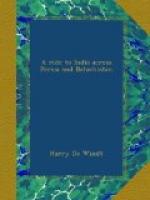“It’s from F——,” he said, a few moments later, “to say he expects you to make his house your head-quarters at Shiraz.” So the stranger is passed on through this desert, but hospitable land. Persian travel would be hard indeed were it not for the ever-open doors and hospitality of the telegraph officials.
We continue our journey next day in summer weather—almost too hot, in the middle of the day, to be pleasant. Sheepskin and bourka are dispensed with, as we ride lazily along under a blazing sun through pleasant green plains of maize and barley, irrigated by babbling brooks of crystal-clear water. A few miles from Abadeh is a cave-village built into the side of a hill. From this issue a number of repulsive-looking, half-naked wretches, men and women, with dark scowling faces, and dirty masses of coarse black hair. Most are covered with skin-disease, so we push on ahead, but are caught up, for the loathsome creatures get over the ground with extraordinary speed. A handful of “sheis” [A] stops them, and we leave them swearing, struggling, and fighting for the coins in a cloud of dust. Then on again past villages nestling in groves of mulberry trees, past more vineyards, maize, and barley, and peasants in picturesque blue dress (save white, no other colour is worn in summer by the country-people) working in the fields. Their implements are rude and primitive enough. The plough is simply a sharpened stick covered with iron. The sickle is used for reaping. Threshing is done by means of an axle with thin iron wheels. If such primitive means can attain such satisfactory results, what could not modern agricultural science be made to do for Persia?
Sunset brings a cool breeze, which before nightfall develops into a cutting north-easter, and we shiver again under a bourka and heavy fur pelisse. Crossing a ridge of rock, we descend upon a white plain, dim and indistinct in the twilight. The ground crackles under our horses’ feet. It is frozen snow! A light shines out before us, however, and by ten o’clock we are snug and safe for the night in the telegraph-station of Deybid.
These sudden changes of temperature make the Persian climate very trying. At this time of year, however balmy the air and bright the sunshine at midday, one must always be prepared for a sudden and extreme change after sunset. The Plain of Deybid was covered with snow at least two feet deep, the temperature must have stood at very few degrees above zero, and yet, not five hours before, we were perspiring in our shirt-sleeves.
“Mashallah!” exclaims Gerome next morning, shading his eyes and looking across the dazzling white expanse. “Are we, then, never to finish with this accursed snow?” By midday, however, we are out of it, and, as we subsequently discover, for the last time.




